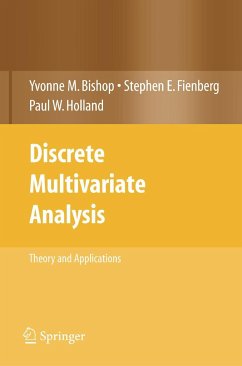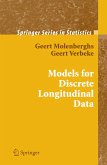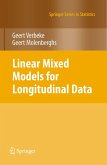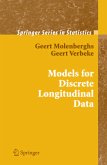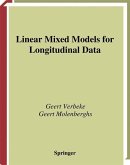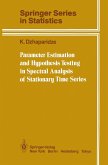6. 2 The Two-Sample Capture-Recapture Problem . . . . . . . . . . . . . . . . . . . . . . . . . . . . . . . . 231 6. 3 Conditional Maximum Likelihood Estimation of N . . . . . . . . . . . . . . . . . . . . . . 236 6. 4 The Three-Sample Census . . . . . . . . . . . . . . . . . . . . . . . . . . . . . . . . . . . . . . . . . . . . . . . . . . . . . . . . . . . . . . 237 6. 5 The General Multiple Recapture Problem . . . . . . . . . . . . . . . . . . . . . . . . . . . . . . . . . . . . . . 246 6. 6 Discussion . . . . . . . . . . . . . . . . . . . . . . . . . . . . . . . . . . . . . . . . . . . . . . . . . . . . . . . . . . . . . . . . . . . . . . . . . . . . . . . . . . . . . . 254 7 MODELS FOR MEASURING CHANGE . . . . . . . . . . . . . . . . . . . . . . . . . . . . . . . . . . . . . . . . . . 257 7. 1 Introduction . . . . . . . . . . . . . . . . . . . . . . . . . . . . . . . . . . . . . . . . . . . . . . . . . . . . . . . . . . . . . . . . . . . . . . . . . . . . . . . . . . . 257 7. 2 First-Order Markov Models . . . . . . . . . . . . . . . . . . . . . . . . . . . . . . . . . . . . . . . . . . . . . . . . . . . . . . . . . . . 261 7. 3 Higher-Order Markov Models . . . . . . . . . . . . . . . . . . . . . . . . . . . . . . . . . . . . . . . . . . . . . . . . . . . . . . . . 267 7. 4 Markov Models with a Single Sequence of Transitions . . . . . . . . . . . . . . . . . . 270 7. 5 Other Models . . . . . . . . . . . . . . . . . . . . . . . . . . . . . . . . . . . . . . . . . . . . . . . . . . . . . . . . . . . . . . . . . . . . . . . . . . . . . . . . . 273 8 ANALYSIS OF SQUARE TABLES: SYMMETRY AND MARGINAL HOMOGENEITY . . . . . . . . . . . . . . . . . . . . . . . . . . . . . . . . . . . . . . . . . . . . . . . . . . . . . . . . . . 281 8. 1 Introduction . . . . . . . . . . . .. . . . . . . . . . . . . . . . . . . . . . . . . . . . . . . . . . . . . . . . . . . . . . . . . . . . . . . . . . . . . . . . . . . . . . . 281 8. 2 Two-Dimensional Tables . . . . . . . . . . . . . . . . . . . . . . . . . . . . . . . . . . . . . . . . . . . . . . . . . . . . . . . . . . . . . . . . 282 8. 3 Three-Dimensional Tables . . . . . . . . . . . . . . . . . . . . . . . . . . . . . . . . . . . . . . . . . . . . . . . . . . . . . . . . . . . . . . 299 8. 4 Summary . . . . . . . . . . . . . . . . . . . . . . . . . . . . . . . . . . . . . . . . . . . . . . . . . . . . . . . . . . . . . . . . . . . . . . . . . . . . . . . . . . . . . . . . 309 9 MODEL SELECTION AND ASSESSING CLOSENESS OF FIT: PRACTICAL ASPECTS . . . . . . . . . . . . . . . . . . . . . . . . . . . . . . . . . . . . . . . . . . . . . . . . . . . . . . . . . 311 9. 1 Introduction . . . . . . . . . . . . . . . . . . . . . . . . . . . . . . . . . . . . . . . . . . . . . . . . . . . . . . . . . . . . . . . . . . . . . . . . . . . . . . . . . . . 311 9. 2 Simplicity in Model Building . . . . . . . . . . . . . . . . . . . . . . . . . . . . . . . . . . . . . . . . . . . . . . . . . . . . . . . . . . 312 9. 3 Searching for Sampling Models . . . . . . . . . . . . . . . . . . . . . . . . . . . . . . . . . . . . . . . . . . . . . . . . . . . . . . 315 9. 4 Fitting and Testing Using the Same Data . . . . . . . . . . . . . . . . . . . . . . . . . . . . . . . . . . . . . . . 317 9. 5 Too Good a Fit . . . . . . . . . . . . . . . . . . . . . . . . . . . . . . . . . . . . . . . . . . . . . . . . . . . . . . . . . . . . . . . . . . . . . . . . . . . . . . 324 9. 6 Large Sample Sizes and Chi Square When the Null Model is False . . . . . . . . . . . . . . . . . . . . . . . . . . . . . . . . . . . . . . . . . . . . . . .. . . . . . . . . . . . . . . . . . . . . . . . . . . . . . . . . 329 9. 7 Data Anomalies and Suppressing Parameters . . . . . . . . . . . . . . . . . . . . . . . . . . . . . . . . 332 9. 8 Frequency of Frequencies Distribution . . . . . . . . . . . . . . . . . . . . . . . . . . . . . . . . . . . . . . . . . . 337 10 OTHER METHODS FOR ESTIMATION AND TESTING IN CROSS-CLASSIFICATIONS . . . . . . . .
From the reviews:
"The book deals with discrete multivariate analysis in an effort to bring together in an organised way the extensive theory and practice existing in this field. It is organised in 14 chapters. ... is well addressed to readers from different background and different interests covering a wide range from graduate students in theoretical statistics to quantitative biological or social scientists, applied statisticians and other quantitative research workers looking for comprehensive analyses of discrete multivariate data." (Christina Diakaki, Zentralblatt MATH, Vol. 1131 (9), 2008)
"The book deals with discrete multivariate analysis in an effort to bring together in an organised way the extensive theory and practice existing in this field. It is organised in 14 chapters. ... is well addressed to readers from different background and different interests covering a wide range from graduate students in theoretical statistics to quantitative biological or social scientists, applied statisticians and other quantitative research workers looking for comprehensive analyses of discrete multivariate data." (Christina Diakaki, Zentralblatt MATH, Vol. 1131 (9), 2008)

